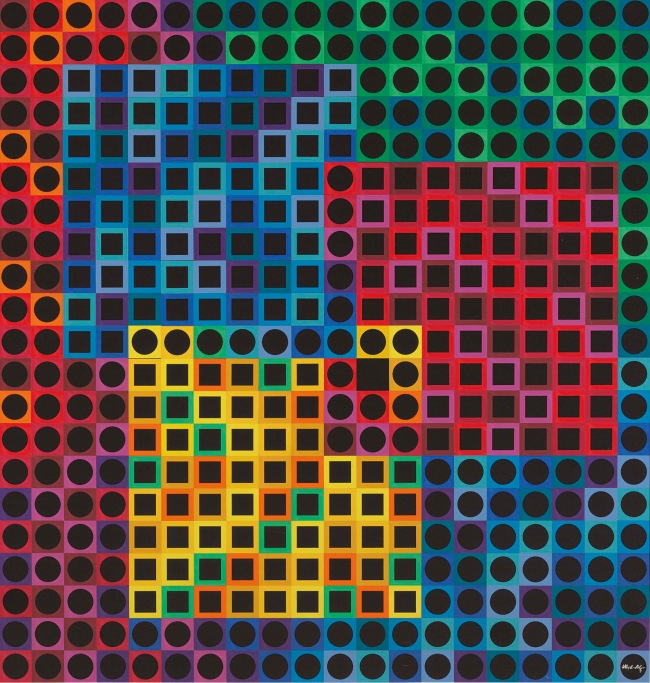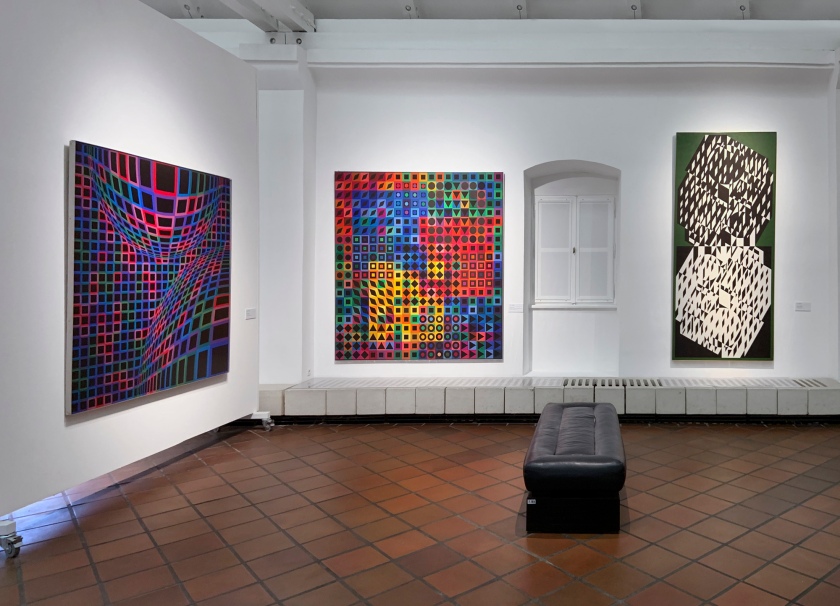Visited September 2019 posted November 2020
Victor Vasarely (Hungarian-French, 1906-1997)
Zebras. Prekinetic study (Preliminary study for the kinetic theory. Graphic Period, 1929-1939) (installation view)
1939
Gouache, pencil, colour and white chalk on paper
Photo: Marcus Bunyan
While on my European art trip in 2019, I ventured by tram to the deepest suburbs of Budapest to visit the Vasarely Museum on a Sunday – one of only three days the museum is open. The journey was an experience in itself. The reward was that I got to see an artists work I have always admired (I have a Vasarely serigraph in my collection), set in one of the most beautiful art galleries I have ever seen in my life. What’s not too like.
Critically, I got to examine Vasarely’s work up close and personal, on a large scale. I noted how gestural his work is, even as it is geometric – emerging from his Gesture Drawings. Ground Plans of 1946. There is a mesmerising flow to his compositions, even as they are supposedly set, fixed, in their mathematical complexity.
Even as Josef Albers explored colour in the belief that colours have no inherent emotional associations, so Vasarely investigated the formula for a “plastic alphabet”, a universal visual language based on the structural interplay of form and colour, a programmed language with an infinite number of form and colour variations. Through serialisation and the processes of re-creation, multiplication and expansion, “in pictures based on the mutual association between forms and colours, he claimed to perceive a ‘grammar’ of visual language, with which a set of basic forms making up a composition could be arranged into a system similar to musical notation… He regarded colour-forms as the cells or molecules out of which the universe was made.”
Don’t believe all that is written on the can. While both artists want to euthanise the authenticity of the hand, the feeling of he eye, and the beauty of the object through an investigation of concept, form and replication, when in the presence of these paintings, once, twice, three times, one cannot deny the intimacy of their construction.
Unlike flat reproductions of these paintings in books, their serial reproduction, in these installation photographs you can see the ripples in the surface of these paintings. Their meticulous, hand-crafted production. For example, look at the surface of paintings such as Lom-Lan 2 (1953, below); Marsan (1950 / 1955 / 1958, below); and Sonora (1973, below). From a distance their patterns are stable but optically disturbing. Up close, their surface dis/integrates into swirls and ripples at a molecular level. The musical annotation – colour, form, pattern, repetition – of these optical illusions is subsumed into an aura, an earthly divination of a transient ‘planetary folklore’.
Dr Marcus Bunyan
.
All iPhone images © Dr Marcus Bunyan. Please click on the photographs for a larger version of the image.
Downstairs galleries
View of the Vasarely Museum Budapest
Photo: Marcus Bunyan
View of the Vasarely Museum, Budapest showing at second left, Gesture Drawings. Ground Plans (1946); and at second right, Composition (1948)
Photo: Marcus Bunyan
Victor Vasarely (Hungarian-French, 1906-1997)
Gesture Drawings. Ground Plans (installation view)
1946
Pencil on paper
Vasarely Museum Budapest
Photo: Marcus Bunyan
The Galerie Denise René opened in 1944. Its first exhibition was Les dessins et composition de Vasarely (Vasarely’s drawings and graphic compositions). Surrealism influenced his works, and even caught the attention of André Breton. As Denise René recalled: ‘André Breton was even convinced we had found a Surrealist painter; it was mostly the trompe l’œils that made him think so, which abounded in Vasarely’s graphic innovations. Breton invited me and Vasarely to visit him in rue Fontaine. Éluard and Breton both came to see the exhibition, though on different days because Éluard had broken with Breton and Surrealism.’ Vasarely had a painterly turn. Shortly he made experimentations in gesture painting. (Victor Vasarely, Jazz, 1942, inv. V. 195) Later, despite his artistic discoveries, he described his earliest period as Les Fausses Routes (Wrong Roads).
Text from the Vasarely Museum website [Online] Cited 26/10/2020
Victor Vasarely (Hungarian-French, 1906-1997)
Hombre en movimiento – Estudio del movimiento (El hombre)
Man in motion. Study of Motion (The Man)
1943
Tempera on plywood
117 x 132cm
Vasarely Museum Budapest
Victor Vasarely (Hungarian-French, 1906-1997)
Composition (installation view)
1948
Oil on canvas
Vasarely Museum Budapest
Photo: Marcus Bunyan
Magyar Grafika (Hungarian Graphics)
Az Ujság Hirdetés (The Newspaper is Advertised) (installation view)
Edition 12
1931
Vasarely Museum Budapest
Photo: Marcus Bunyan
A journal for the development of graphic industries and related professions. Budapest, 1. 1920 – 13. 1932
Installation views of the Vasarely Museum, Budapest with in the last photo at left, Versant (1952)
Photos: Marcus Bunyan
Victor Vasarely (Hungarian-French, 1906-1997)
Versant (installation view)
1952
Acrylic on plywood
Vasarely Museum Budapest
Photo: Marcus Bunyan
Installation view of the Vasarely Museum, Budapest with at right, Lom-Lan 2 (1953)
Photo: Marcus Bunyan
Victor Vasarely (Hungarian-French, 1906-1997)
Lom-Lan 2 (installation view)
1953
Oil on fibreboard
Vasarely Museum Budapest
Photo: Marcus Bunyan
Installation views of the Vasarely Museum, Budapest showing the painting Amir (“Rima”) 1953 (installation view)
Photos: Marcus Bunyan
Victor Vasarely (Hungarian-French, 1906-1997)
Amir (“Rima”) (installation view)
1953
Acrylic on plywood
Vasarely Museum Budapest
Photo: Marcus Bunyan
Victor Vasarely (Hungarian-French, 1906-1997)
MORA (Oeuvre profonde cinétique) (installation views)
1954/1960 (?)
Deep kinetic object, silk screen on plexiglas, glass and steel
Vasarely Museum Budapest
Photos: Marcus Bunyan
Installation view of the Vasarely Museum, Budapest showing at left, Orion noir (1970); and at right, Norma (1962-1979)
Photo: Marcus Bunyan
Victor Vasarely (Hungarian-French, 1906-1997)
Orion noir
1970
Acrylic on canvas
Vasarely Museum Budapest
Victor Vasarely (Hungarian-French, 1906-1997)
Norma (installation view)
1962-1979
Acrylic on canvas
Vasarely Museum Budapest
Photo: Marcus Bunyan
Installation view of the Vasarely Museum, Budapest
Photo: Marcus Bunyan
Victor Vasarely (Hungarian-French, 1906-1997)
Chess Set
1980
Multiple, plexiglass
Vasarely Museum Budapest
Photos: Marcus Bunyan
Installation view of the Vasarely Museum, Budapest showing at left, Marsan-2 (1964/1974); at centre, Gizeh (1955/1962); and at right, Marsan (1950/1955/1958)
Photo: Marcus Bunyan
Victor Vasarely (Hungarian-French, 1906-1997)
Marsan-2 (installation views)
1964/1974
Acrylic on canvas
Vasarely Museum Budapest
Photos: Marcus Bunyan
Victor Vasarely (Hungarian-French, 1906-1997)
Gizeh (installation view)
1955/1962
Oil on canvas
Donation of Victor Vasarely, 1970
Vasarely Museum Budapest
Photo: Marcus Bunyan
Victor Vasarely (Hungarian-French, 1906-1997)
Marsan (installation view)
1950/1955/1958
Oil on canvas
Donation of Victor Vasarely, 1970
Vasarely Museum Budapest
Photo: Marcus Bunyan
Victor Vasarely (Hungarian-French, 1906-1997)
Naissances (installation view)
1954/1960
From the album Hommage à Johann Sebastian Bach (Éd. Pierre belford, Paris, 1973. Éxemplaire XIV/XX), Supplement no. 3.
Deep kinetic object, plexiglass, silk screen
Vasarely Museum Budapest
Photo: Marcus Bunyan
Victor Vasarely (Hungarian-French, 1906-1997)
Zilia (installation view)
1981
Acrylic on canvas
Vasarely Museum Budapest
Photo: Marcus Bunyan
Victor Vasarely (Hungarian-French, 1906-1997)
Stridio-Z (installation view)
1976-1977
Acrylic on canvas
Vasarely Museum Budapest
Photo: Marcus Bunyan
Victor Vasarely (Hungarian-French, 1906-1997)
Tri-Axo (installation view)
1972/1976
Acrylic on canvas
Vasarely Museum Budapest
Photo: Marcus Bunyan
William Seitz
The responsive eye (book cover)
Museum of Modern Art, 1965
Photo: Marcus Bunyan
Installation view of the Vasarely Museum, Budapest
Photo: Marcus Bunyan
Installation view of the Vasarely Museum, Budapest showing Yllus (1978)
Photo: Marcus Bunyan
Victor Vasarely (Hungarian-French, 1906-1997)
Yllus
1978
Acrylic on canvas
Vasarely Museum Budapest
Photo: Marcus Bunyan
Upstairs galleries
Installation view of the Vasarely Museum, Budapest
Photo: Marcus Bunyan
Installation view of the Vasarely Museum, Budapest showing V.P. 102 (1979)
Photo: Marcus Bunyan
Victor Vasarely (Hungarian-French, 1906-1997)
V.P. 102 (installation view)
1979
Acrylic on cardboard, mounted on plywood
Vasarely Museum Budapest
Photo: Marcus Bunyan
Installation view of the Vasarely Museum, Budapest showing at left in the display cabinet, KROA-MC (1969); and at centre, Quivar (Ouivar) (1974)
Photo: Marcus Bunyan
Installation view of the Vasarely Museum, Budapest showing at left, Eroed-Pre (1978); and at right, Quivar (Ouivar) (1974)
Photo: Marcus Bunyan
Victor Vasarely (Hungarian-French, 1906-1997)
Eroed-Pre (installation view)
1978
Acrylic on canvas
Vasarely Museum Budapest
Photo: Marcus Bunyan
Victor Vasarely (Hungarian-French, 1906-1997)
Quivar (Ouivar) (installation view)
1974
Collage, gouache on cardboard, mounted on plywood
Vasarely Museum Budapest
Photo: Marcus Bunyan
Installation view of the Vasarely Museum, Budapest showing at right, Stri-oet (1979)
Photo: Marcus Bunyan
Victor Vasarely (Hungarian-French, 1906-1997)
Stri-oet (installation view)
1979
Acrylic on canvas
Vasarely Museum Budapest
Photo: Marcus Bunyan
Installation view of the Vasarely Museum, Budapest showing at left centre, Stri-oet (1979); and in the display cabinet, KROA-MC (1969). Love the reflection of the colours on the wall behind!
Photo: Marcus Bunyan
Installation view of the Vasarely Museum, Budapest showing KROA-MC (1969)
Photo: Marcus Bunyan
Installation view of the Vasarely Museum, Budapest showing at left, Bull (1973/74); and at centre left, Orion noir (1963)
Photo: Marcus Bunyan
Victor Vasarely (Hungarian-French, 1906-1997)
Bull (installation view)
1973/1974
Acrylic on canvas
Vasarely Museum Budapest
Photo: Marcus Bunyan
Victor Vasarely (Hungarian-French, 1906-1997)
Vega Mir (Oeuvre profonde cinétique) (installation view)
1954/1960
From the album Hommage à Johann Sebastian Bach (Éd. Pierre belford, Paris, 1973. Éxemplaire XIV/XX), Supplement no. 1.
Multiple, silk screen on anodised aluminium
Vasarely Museum Budapest
Photo: Marcus Bunyan
Victor Vasarely (Hungarian-French, 1906-1997)
Vega Mir (Oeuvre profonde cinétique) (installation view detail)
1954/1960
From the album Hommage à Johann Sebastian Bach (Éd. Pierre belford, Paris, 1973. Éxemplaire XIV/XX), Supplement no. 1.
Multiple, silk screen on anodised aluminium
Vasarely Museum Budapest
Photo: Marcus Bunyan. Self portrait with ‘Vega Mir’ 2019
Installation view of the Vasarely Museum, Budapest showing at left, Bi. Octans (1979)
Photo: Marcus Bunyan
Victor Vasarely (Hungarian-French, 1906-1997)
Bi. Octans (installation view)
1979
Acrylic on canvas
Vasarely Museum Budapest
Photo: Marcus Bunyan
Installation view of the Vasarely Museum, Budapest showing at left, Kotzka (1973-1976); and at right, Trybox (1979)
Photo: Marcus Bunyan
Victor Vasarely (Hungarian-French, 1906-1997)
Kotzka (installation view)
1973-1976
Acrylic on canvas
Vasarely Museum Budapest
Photo: Marcus Bunyan
Victor Vasarely (Hungarian-French, 1906-1997)
Trybox (installation view)
1979
Acrylic on canvas
Vasarely Museum Budapest
Photo: Marcus Bunyan
Installation view of the Vasarely Museum, Budapest showing at centre right, Vonal-Ket (1972/1977)
Photo: Marcus Bunyan
Victor Vasarely (Hungarian-French, 1906-1997)
Vonal-Ket (installation views)
1972/1977
Acrylic on canvas
Vasarely Museum Budapest
Photos: Marcus Bunyan
Installation view of the Vasarely Museum, Budapest showing at centre left, Sonora (1973)
Photo: Marcus Bunyan
Victor Vasarely (Hungarian-French, 1906-1997)
Sonora (installation view)
1973
Acrylic on canvas
Vasarely Museum Budapest
Photo: Marcus Bunyan
Vasarely Museum
1033, Budapest Szentlélek tér 6
Phone: + 36 1 388 7551
Opening hours:
Friday 11am – 4.00pm
Saturday – Sunday 11am – 4.00pm































































You must be logged in to post a comment.